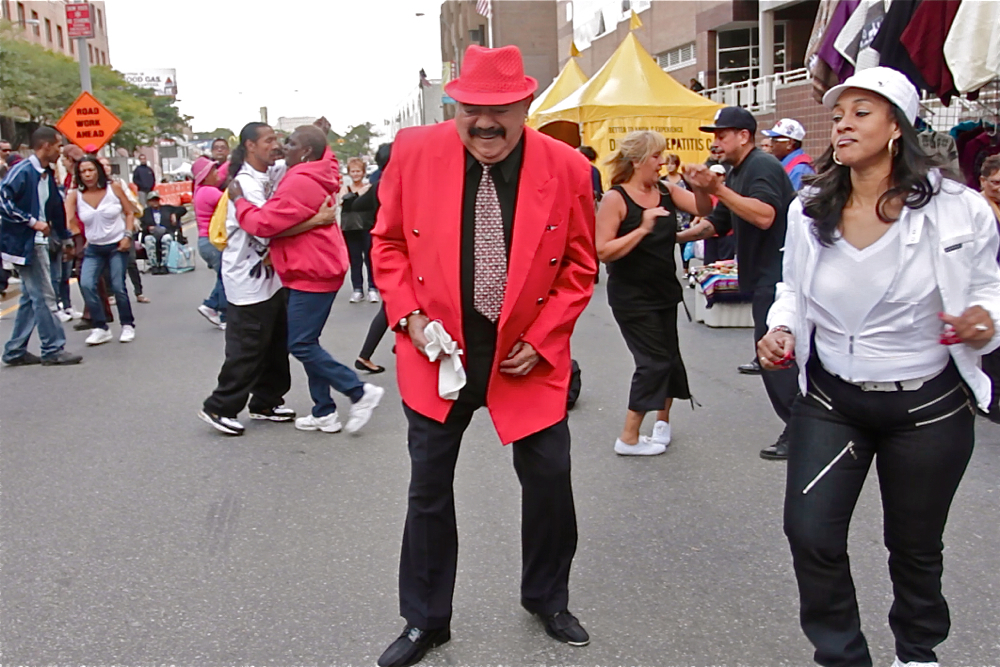hadi_story_vivabronx_001
The big man toe tapped with grace and flash that matched his fire-engine red coat and hat. He may be large, but the man knew his steps. If he missed one, it wasn’t because his partner was better at salsa. It was because half a dozen genres of music were playing on this street – everything from Latino pop to Caribbean reggae and African rap.
Every year, on the first Sunday of October, five blocks on the Grand Concourse in Mott Haven – from 144th to 149th streets, through Hostos College – erupt into a passionate display of color and music. From brunch to sundown, Bronxites of all ethnicities revel in a carnival of foods, crafts, games and prizes. Upcoming and established talents from the borough perform on stage and on the street to a packed crowd of thousands.
But this year, that audience was reduced by a third. Viva Bronx, or Bronx Alive, wasn’t as alive as it used to be. “We used to get a crowd of 10 to 15,000, popping in and out,” said Hernand Gonzalez, whose Miami-based company has produced the festival for the past few years. “This time, even 5,000 would be stretching it too far.”
It wasn’t just the crowds; there were fewer vendors as well. “I just couldn’t believe how empty it was,” said Maria Docarmo, who came all the way from Mount Vernon to set up her clothes stall. “There used to be so many of us every year, especially food vendors. This year, there was just one stall with kebabs and lemonade.”
The dip in participation at Viva Bronx comes at a time when several street fairs have been discontinued across the city because they couldn’t raise the funds they needed. “It’s the economy,” explained Wallace Edgecombe, Arts and Culture Director at Hostos College, who started the festival in 2005 with a seed grant from the Bronx Council of the Arts. “It takes a lot of money to organize fairs like this, and getting sponsors in this recession is becoming difficult.” Instead of the cola giants and top insurance companies that participated in previous years, the only big advertisers this time were Optimum Online, Vertex Pharmaceuticals’ FindHepC campaign, and the US Marines.
“This festival has always been held with Hostos’ homecoming,” said Edgecombe. “But this year the alumni decided to take a rest.” Hostos’ alumni office said that the homecoming is now a biennial event, because “it needed more time and effort.” Funds for the homecoming too depend in part on sponsors.
The performers felt let down by the low turnout. “It was much better last year, even though the weather was bad,” said Kurt Woodley, a music industry veteran who helps launch local artists. “This time, despite it being a beautiful day, people just haven’t come out. Maybe it’s because the show isn’t as big.”
Woodley was at Viva Bronx with his latest project, the Rok Fairies, Bronx’s Latina version of the Spice Girls. But as Sassy Alejandra and Flawless Kendri wrapped up their performance, he felt they could have picked a better stage debut for their latest single. “This fest used to attract a lot of big stars,” said Woodley. “Tito Puente Jr. closed the show last year. This time, the performers just weren’t as many, or as big.”
Still, Edgecombe and Gonzalez are determined that the show must go on. “Mullti-block permits for street events are not easy to get,” said Edgecombe. “If we lose this one, we won’t get it back.”
Michael Max Knobbe, who heads BronxNet TV, agreed that the festival is crucial to this community’s development. “You see a lot of organizations here that want to connect with the community with information and opportunities,” he said. “You see all of them here, between the food and music.”
As it got darker, the salsa tunes wound down and the dancing couples closed their moves with the traditional dip. And everyone – the public, the vendors, the organizers – went home, hoping that this festival would be back next year, and survive what seems to be a second dip.




